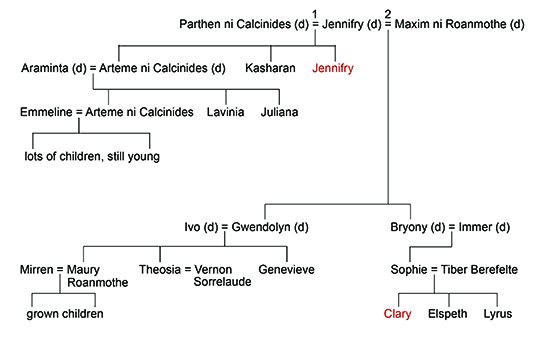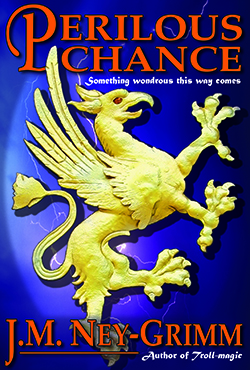It started with a vivid snippet: the vision of an old, abandoned quarry overgrown by brambles and the certainty that a troll was involved.
Next came the entrance of Clary, an eleven-year-old girl, and her sister Elspeth. For a while I thought Elspeth was named after her great grandmother Jennifry nish Roanmothe. But she wasn’t. She was Elspeth, no question.
The troll seemed to be both good and evil, which was confusing until I understood there were two trolls. Aha! And then I discovered that kinship existed between the little girls and the trolls. Time to draw a family tree. I needed to know just what that kinship was.

Before I received my revelation about the troll sisters, another intense vision swept through my mind’s eye: the shabby, disordered front room of Clary’s cottage. Her parents were weary, so weary they were neglectful. What made them so? I didn’t know, but I jotted notes for what would become an early scene in my story: dining table cluttered with last night’s supper, cloth hanging askew.
There I stopped for two weeks, letting the story lie fallow while I devoted myself to publisher tasks. I believe I worked on the print edition for Troll-magic.
When I returned to Perilous Chance, the image of a pegasus took me by storm; it was coal-black and shining, and bursting from the egg. With wings, are pegasi born from eggs? Or, with equine bodies, are they birthed live from their mothers? The answer still awaits me, because Clary’s encounter with a fabulous beast does not feature a pegasus after all. The scene from a future story had arrived, not to be incorporated into this one, but to spark a necessary idea.
No, Clary’s creature was not a pegasus, but I knew what it might be. I did some research: king of the beasts, king of the birds, powerful and majestic, symbol of divine power, and guardian of the divine. Yes! (But I’m not telling here. Too much of a spoiler!)
Once I had these pieces – two girls, enervated parents, two trolls, and a miracle-bearing beast – my story fell into place. I made a rough outline and started writing.
In three places I faltered.
The first was the simplest. How did Clary’s father make a living? He did not possess inherited wealth. He worked with his hands, but he was more than a simple craftsman. He didn’t fashion “bramble furniture” as I’d initially believed. Nor was he a businessman, supplying city households with the products of craftsmen under his organization. What did he do? He worked with his hands, but made decent money from it and received considerable respect.
If I ask myself a question with enough variations, I usually get an answer. It turned out that Tiber was a sculptor, and a renowned one at that. He designed the fountain in the main square of Auberon’s capital city and sculpted the horses cavorting under its play of water. He regularly receives commissions from the Morofane himself.
That settled, I wrote on. And reached a point of resolution. Was this the end? Events were resolved, but it didn’t feel like the end. I sought a first reader’s opinion. Was it finished? No, it was not. But no wonder I wanted it to be. In order to write the proper denouement, I needed to comprehend the judicial system of Auberon better than I did.
I set to work, researching a bit, brainstorming more. And I figured out enough to go forward. The current Rofane ni Calcinides is Justicar of the Peace. Local disputes and crimes are handled under his purview. Several wardens and a secretary, appointed by the royal judiciary, work under his leadership.
Writing the validation was easy after that. I knew where to place emphasis – Clary’s experience – and where to glide lightly – the visit to Arteme’s manor. And then I was done.
Excepting one problem: my opening wasn’t quite right.
I studied the openings written by my favorite authors. Why were they so effective? What was their underlying structure?
All About Emily by Connie Willis supplied me with the structure that would work for Perilous Chance. In Emily, Willis begins with a paragraph describing the protagonist’s predicament from much later in the story. That was what I wanted! And I knew exactly what piece I would use. Now my tale truly was complete.
 She was eleven, and she was hurt. Her leg lay under her, knee throbbing. Her arm ached, the broken bone within sickening in its pain. But worst of all, worst of all, a vast shadow loomed above her, dark wings spanning distances too great for the grotto enclosing them, razor-sharp talons sparking with the spitting blue fire of a strange power.
She was eleven, and she was hurt. Her leg lay under her, knee throbbing. Her arm ached, the broken bone within sickening in its pain. But worst of all, worst of all, a vast shadow loomed above her, dark wings spanning distances too great for the grotto enclosing them, razor-sharp talons sparking with the spitting blue fire of a strange power.
“No, please, no,” she whispered.
How had it come to this? Her day had started so ordinarily, getting breakfast for herself and her sister, because Mama could not. She cast her thoughts desperately back to the morning. I’m there. Not here. I’m there.
Something wondrous this way comes!
Amazon I B&N I iTunes I Kobo I Smashwords
For more about the stories behind my stories, see:
Dreaming the Star-drake
Writing Sarvet
Behind Troll-magic
For more about Perilous Chance:
Justice in Auberon
Clary’s Cottage
Not Monday, But Lundy
Cover Creation: Perilous Chance

I love to see “behind the curtain” like this–it gives a clear view of the process a writer goes through when crafting a story. One thing I think some readers don’t think about (because it’s not their job to, in all honesty) is all the background that doesn’t make it into a story. But that’s often the most interesting part.
It also reminds me that I need to be more disciplined in my own background research. I have lots of ideas, but I’m honestly not that good at fleshing them out completely–the result is often that the story feels unfinished, or unsupported. A good reminder!
Oh, good! I thought readers might find this interesting, but it’s hard to be sure. As the writer, I know all those unexpressed details and find them enthralling, but they’re not in the story for a reason. Glad you liked this!
BTW, there’s another “behind the curtain” of a story post here. About The Troll’s Belt.
I’ll have to take a look!
As for behind the scenes looks–the Silmarillion is little more than background research! There’s an audience somewhere.